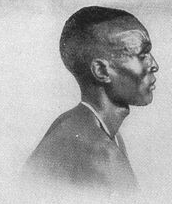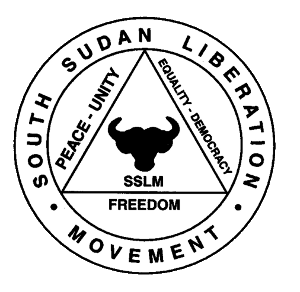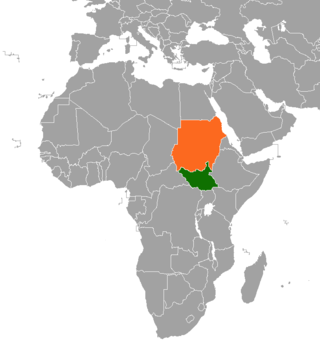Related Research Articles

Jonglei State is a state of South Sudan with Bor as its centre of government and the biggest city. Jonglei state comprises nine counties: Bor, Akobo, Ayod, Uror, Duk, Nyirol, Pigi, Twic East, and Fangak. Jonglei State is the largest state by area before reorganisation, with an area of approximately 122,581 km2, as well as the most populous according to the 2008 census conducted in present-day South Sudan's second period of autonomy. The boundaries of the state were again changed as a result of a peace agreement signed on 22 February 2020.

The Dinka tribe are a Nilotic ethnic group native to South Sudan with a sizable diaspora population abroad. The Dinka mostly live along the Nile, from Bor to Renk, in the region of Bahr el Ghazal, Upper Nile, and the Abyei Area of the Ngok Dinka in South Sudan.

The Nuer people are a Nilotic ethnic group concentrated in the Greater Upper Nile region of South Sudan. They also live in the Ethiopian region of Gambella. The Nuer speak the Nuer language, which belongs to the Nilotic language family. They are the second largest ethnic group in South Sudan. The Nuer people are pastoralists who herd cattle for a living. Their cattle serve as companions and define their lifestyle. The Nuer call themselves "Naath".
The Nuer language (Thok Naath) ("people's language") is a Nilotic language of the Western Nilotic group. It is spoken by the Nuer people of South Sudan and in western Ethiopia (region of Gambela). The language is very similar to Dinka and Atuot.

The Second Sudanese Civil War was a conflict from 1983 to 2005 between the central Sudanese government and the Sudan People's Liberation Army. It was largely a continuation of the First Sudanese Civil War of 1955 to 1972. Although it originated in southern Sudan, the civil war spread to the Nuba mountains and the Blue Nile. It lasted for almost 22 years and is one of the longest civil wars on record. The war resulted in the independence of South Sudan 6 years after the war ended.

The South Sudan Liberation Movement (SSLM) is an armed group that operates in the Upper Nile Region of South Sudan. The group's creation was announced in November 1999 by people of the Nuer ethnicity who were in both the rebel Sudan People's Liberation Army (SPLA) and the government-allied South Sudan Defence Forces (SSDF) gathered in Waat. The SSLM was declared to be unaligned in the Second Sudanese Civil War, then entering its sixteenth year. The name "South Sudan Liberation Movement" was decided upon the next year, borrowing from the earlier Southern Sudan Liberation Movement, which existed in the 1980s.
The dozen Luo, Lwo or Lwoian languages are spoken by the Luo peoples in an area ranging from southern Sudan to western Ethiopia to southern Kenya, with Dholuo extending into northern Tanzania and Alur into the Democratic Republic of the Congo. They form one of the two branches of the Western Nilotic family, the other being the Dinka–Nuer. The Southern Luo varieties are mutually intelligible, and apart from ethnic identity they might be considered a single language.

The Shilluk are a major Luo Nilotic ethnic group of Southern Sudan, living on both banks of the river Nile, in the city of Malakal. Before the Second Sudanese Civil War the Shilluk also lived in settlements on the northern bank of the Sobat River, close to where the Sobat joins the Nile.
The Murle are a Surmic ethnic group inhabiting the Pibor County and Boma area in Greater Pibor Administrative area, South Sudan, as well as parts of southwestern Ethiopia. They have also been referred as Beir by the Dinka and as Jebe by the Luo and Nuer, among others. The Murle speak the Murle language, which is part of the Surmic language family. The language cluster includes some adjoining groups in Sudan, as well as some non-contiguous Surmic populations in southwestern Ethiopia.

The Lost Boys of Sudan refers to a group of over 20,000 boys of the Nuer and Dinka ethnic groups who were displaced or orphaned during the Second Sudanese Civil War (1987–2005). Two million were killed and others were severely affected by the conflict. The term was used by healthcare workers in the refugee camps and may have been derived from the children's story of Peter Pan by J. M. Barrie. The term also was used to refer to children who fled the post-independence violence in South Sudan in 2011–2013.
Abeed or abīd, is an Arabic word meaning "servant" or "slave". The term is used sometimes in the Arab world as an ethnic slur for Black people, and dates back to the Arab slave trade. In recent decades, usage of the word has become controversial due to its racist connotations and origins, particularly among the Arab diaspora.
Ma'di is a Central Sudanic language found in Uganda and South Sudan. It is one of the Moru–Madi languages. The Madi people refer to their language as Ma'di ti, literally "Ma'di mouth".
Sudanese Americans are Americans of Sudanese ancestry, or Sudanese who have American citizenship. Sudanese Americans may also include children born in the United States to an American parent and a Sudanese parent. Many Sudanese immigrated to the United States in the 1990s as war refugees, escaping of civil war in Sudan. In the 2012 American Community Survey, 48,763 people identified themselves as Sudanese or Sudanese Americans who—or whose ancestors—have emigrated from their native land to the U.S. in the 1980s, 1990s and 2000s.

Sudanese nomadic conflicts are non-state conflicts between rival nomadic tribes taking place in the territory of Sudan and, since 2011, South Sudan. Conflict between nomadic tribes in Sudan is common, with fights breaking out over scarce resources, including grazing land, cattle and drinking water. Some of the tribes involved in these clashes have been the Messiria, Maalia, Rizeigat and Bani Hussein Arabic tribes inhabiting Darfur and West Kordofan, and the Dinka, Nuer and Murle African ethnic groups inhabiting South Sudan. Conflicts have been fueled by other major wars taking place in the same regions, in particular the Second Sudanese Civil War, the War in Darfur and the Sudanese conflict in South Kordofan and Blue Nile.

The culture of South Sudan encompasses the religions, languages, ethnic groups, foods, and other traditions of peoples of the modern state of South Sudan, as well as of the inhabitants of the historical regions of southern Sudan.

South Sudan is home to around 60 indigenous ethnic groups and 80 linguistic partitions among a 2021 population of around 11 million. Historically, most ethnic groups were lacking in formal Western political institutions, with land held by the community and elders acting as problem solvers and adjudicators. Today, most ethnic groups still embrace a cattle culture in which livestock is the main measure of wealth and used for bride wealth.
Ethnic violence in South Sudan has a long history among South Sudan's varied ethnic groups. South Sudan has 64 tribes with the largest being the Dinkas, who constitute about 35% of the population and predominate in government. The second largest are the Nuers. Conflict is often aggravated among nomadic groups over the issue of cattle and grazing land and is part of the wider Sudanese nomadic conflicts.

A Long Walk to Water is a short novel written by Linda Sue Park and published in 2010. It blends the true story of Salva Dut whose story is based in 1985, a part of the Dinka tribe and a Sudanese Lost Boy, and the fictional story of Nya whose story is based in 2008, a young village girl that was a part of the Nuer tribe. Park used this book as a platform to support Dut's organization, Water for South Sudan. It is a powerful work of fiction that is based on a true story, chronicling the journeys of two young children who are struggling to survive in war-torn Sudan.

The Dinka–Nuer West Bank Peace & Reconciliation Conference of 1999 was held in what was then the Southern part of Sudan. It is commonly called the "Wunlit Peace Conference" after Wunlit, the village where it was held in eastern Tonj County in Bahr El Ghazal. The conference brought together Nuer from Western Upper Nile and Dinka from Tonj, Rumbek, and Yirol. It is the most prominent and comprehensively documented case of a people-to-people peace process in what is now the Republic of South Sudan.
The disarmament of the Lou Nuer was a forcible disarmament campaign undertaken by the SPLA in Southern Sudan in December 2005. While other groups had been peacefully disarmed, the Lou section of the Nuer in Northern Jonglei State refused to comply. The SPLA organized a force under Peter Bol Kong to forcibly disarm the Lou Nuer, whose White Army resisted until a defeat in the battle of Motot, after which they fled the area.
References
- 1 2 3 4 5 6 Sudan Envoy Goes from Rebel to Diplomat. Posted by Michele Kelemen on May 21, 2007 6:00 AM.
- 1 2 3 4 5 6 7 8 Encyclopedia of Chicago: Sudanese in Chicago. Posted by Elizabeth E. Prevost. Retrieved September 4, 2012, to 23: 30pm.
- 1 2 3 4 5 6 7 Sudanese community has diverse makeup. Posted by Tom Bell on March 15, 2010. Retrieved November 30, 23:30 pm.
- 1 2 "Sudanese Page - Trinity Lutheran Church". Archived from the original on 10 March 2016. Retrieved 26 July 2016.
- 1 2 University of Nebraska: Sudan and Nebraska. The Abbott Sisters Living Legacy Project.
- 1 2 3 4 Sudanese Refugess Call Omaha a New Home: A Journey Well Worth It Archived 2013-12-04 at the Wayback Machine . Posted by Ashley B, Nyayena C, Nyayop B, Molly B, and Bridget M. Retrieved November 30, 18:40 pm.
- 1 2 3 Lost Boys of Sudan, official IRC website.
- 1 2 3 4 Burbach, C. "Rally features Sudanese vice president." Omaha World-Herald . July 22, 2006.
- 1 2 NEW ISSUES IN REFUGEE RESEARCH. Written by Lacey Andrews Gale and posted in June 2011
- 1 2 Los Angeles Times: Southern Sudanese in Southern California dream of forging a new nation. Posted by Alexandra Zavis.
- 1 2 3 "Baylor University - Libraries - Technology for Faculty -- BearSpace" . Retrieved 26 July 2016.
- ↑ The Gazette. The Sudan Project: Being Sudanese American in Iowa Archived 2013-12-08 at the Wayback Machine . Posted by Kalle Eko.
- ↑ Lost Boy of Sudan Makes North Carolina Home. Posted by Billy Ball, on April 1, 2010
- ↑ Why Sudanese-American Children Are Learning Their Parents’ Language. Posted by Annie Feidt on May 23, 2011. Retrieved September 2, 2:26 pm.
- ↑ VAD: Working with the Sudanese diaspora in the U.S. Archived 2013-12-03 at the Wayback Machine Retrieved November 30, 2011, to 0:08 pm.
- ↑ http://www.ssccsd.org/ Southern Sudanese Community Center of San Diego
- ↑ New Sudan American Hope. Retrieved November 30, 2011, to 0:43 pm.